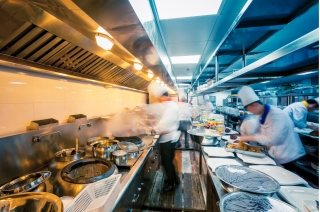
Creating a More Accessible Cooking and Learning Environment
31 October 2023Culinarians learn about stress and anxiety-reducing tactics to create a team that gets the job done.
By Thomas Meyer, National Louis University/Kendall College
Feedback & comments: This email address is being protected from spambots. You need JavaScript enabled to view it.
The stress and challenges of the food industry can be difficult to endure, especially for a person suffering from a mental health illness or other stress-related issues. Modern chefs are just beginning to understand how encouraging and supporting kitchen staff leads to a more stable and skilled workforce. By learning about the impacts of stress and the difference between stress and mental health disorders, today’s chefs are creating a more accessible cooking environment. Shouldn’t culinary instructors do the same?
A balance is beginning to be struck between the authoritarian, “Yes, Chef” mentality and a more compassionate attitude that embraces people who want to enter the food industry. This evolution is seeing fewer chefs yelling, cursing and creating an intolerable environment (even more intolerant for someone with a mental health illness) to a more adaptable workspace. Chefs are finding the key to this new understanding is recognizing and initiating positive strategies that help create a team or brigade while still getting the job done.
Instructors can impart this chef’s knowledge in the classroom too. Better mental health and stress education empowers the instructor to better prepare students for work and service in the food industry.
Here are some key stress types that happen either individually or together and apply to the classroom and professional kitchen.
- Contextual stress occurs in the immediate environment and comes in many forms. In the classroom it may be stress surrounding exams, completing assignments at the proper deadlines and general student time constraints. In the kitchen, contextual stress can develop when food prepping and cooking, meeting serve time, plating consistently or plating the correct portion.
- Time-limited stress is often confined and occurs during specific periods such as taking an exam or during service. Servers or cooks often report feeling physical symptoms associated with time-limited stress (headaches, fatigue and irritability) when they have fallen behind or are “in the weeds.”
- Specific trigger stress is caused by a task or event. For example, in the classroom, a student without full command of English may be assigned an oral presentation and will develop this form of stress knowing that he or she is required to speak in front of the class. In the kitchen, specific trigger stress may take the form of anxiety and dread that occurs when the employee is required to plate a specific way and he or she does not know how or does not have the required confidence.
When an instructor witnesses a person exhibiting symptoms related to these three types of stress, he or she can use stress management strategies. A teacher might help the student create better study habits or seek additional academic support. Click here to read a previous article, “Understanding students’ needs when mental health enters the classroom,” featuring anxiety-relieving suggestions.
A chef in the kitchen can look to make changes in staffing levels related to work volume. Another tactic might be creating better-organized prep lists and making sure staff understands what needs to be done. A chef might also try to be more available and accessible to answer questions during service or schedule a more-experienced person to work with someone with less experience at a station.
Persistent stress may affect a person’s overall well-being and can lead to long-lasting mental health illnesses, such as anxiety disorders and depression. Mental health illness may not always have a clear external cause but can affect a person’s work and daily functioning. Creating a more open, welcoming environment, whether in the classroom or kitchen, occurs when instructors or chefs become better educated in the mental health areas, use these new skills to derive a clearer assessment of an individual within a situation, and then provide proper guidance. This is how a more stable and skilled workforce and classroom is created.
